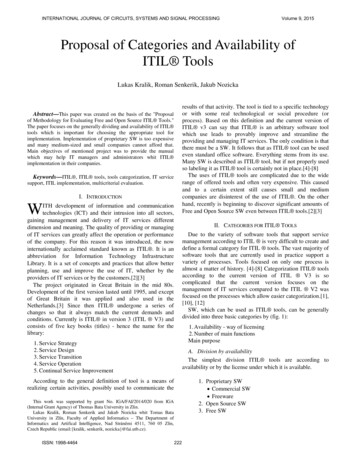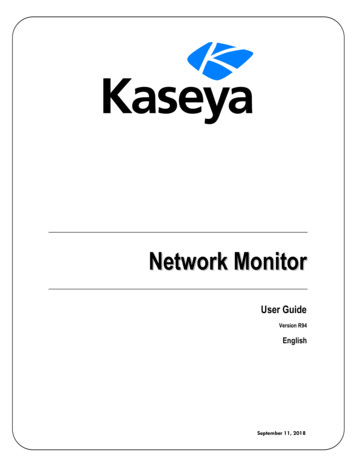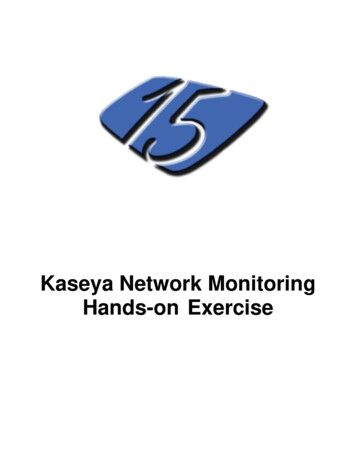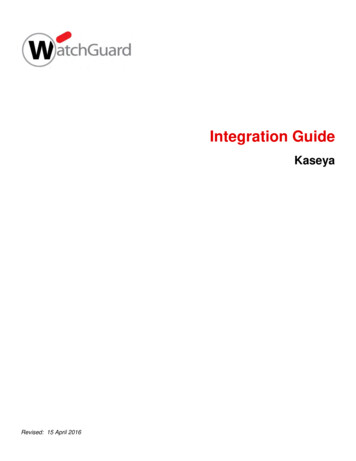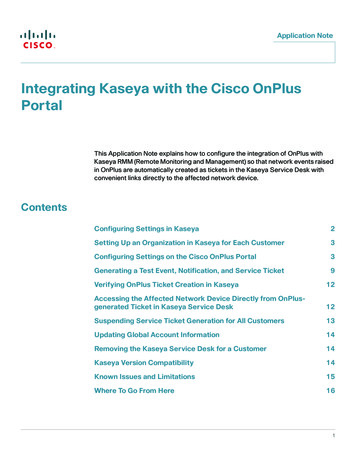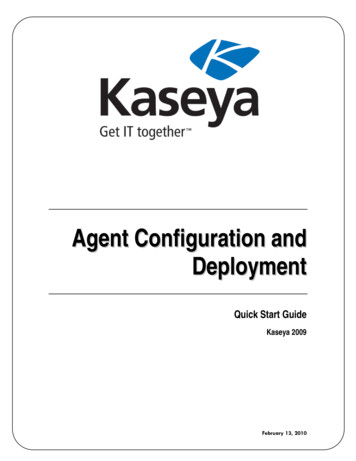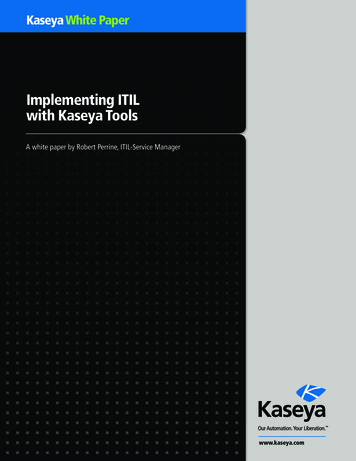
Transcription
Kaseya White PaperImplementing ITILwith Kaseya ToolsA white paper by Robert Perrine, ITIL-Service Managerwww.kaseya.com
Kaseya White Paper Implementing ITIL with Kaseya ToolsExecutive OverviewKaseya Service Desk provides the logic and tools necessary to guide a company intoITIL – the most widely used standard for the efficient operation of an IT organization.Kaseya Service Desk tools are intuitive and easy to use. The goal for this suite is to giveyou ITIL in a box. This release includes Incident Management, Service RequestManagement, Problem Management and Change Management.IntroductionITIL1 stands for Information Technology Infrastructure Library. The ITIL standard describesbest practices for IT. ITIL began as a British standard. Now the core elements of ITIL are aworld-wide standard through ISO 2000 from the International Standards Organization.ITIL defines the roles and responsibilities for an IT organization. For example, ITIL separatesthe duties of rapidly responding to incidents from the responsibility for proactive problemprevention. The reason for doing this is to help people focus. The rapid responders need tobe always at the ready. They cannot get tangled up in complex problems that will takeweeks to research. And the people doing the difficult research need to be protected frominterruptions. ITIL defines Incident Management and Problem Management as distinctdisciplines and gives each clear direction on what to do.The roles within ITIL describe how to organize an IT shop for efficiency. The problem isthat most IT organizations today are not aligned with ITIL. And transitioning into a neworganizational structure is difficult work. What companies need is a tool to help themthrough the transition into ITIL. The minimum requirement for such a tool is the abilityto clearly separate the duties of Incident Management, Service Request Fulfillment,Problem Management and Change Management.Kaseya Service Desk is one tool that gives an IT organization ITIL in a package.1ITIL compliance is a process and method of doing business that each IT team must implement, manage and monitor for itself.And while Kaseya Service Desk customers have a huge leg up with a cutting edge ITIL compliance tool, the mere use of Kaseyaproducts or services does not give or guarantee ITIL compliance. It is the sole responsibility of each customer to understand theITIL compliance rules and process and to implement, manage and monitor any ITIL compliance efforts for the Customer’s ownaccount. Kaseya does not offer ITIL compliance services or advice and the content contained in this whitepaper is provided forinformational purposes only and without warranty of any kind. Kaseya will have no liability relating to any ITIL compliance effortsor the content of this whitepaper.
Kaseya White Paper Implementing ITIL with Kaseya ToolsService DeskAn ITIL Service Desk is the single point of contact for the people that use IT services. Monitoring events, telephone calls, email,requests for status and requests for service all route through the Service Desk.The first priority for the people working the Service Desk is to identify theEventsnature of the message. Is the person calling to report a new incident,PhoneCallsChangeor check on the status of an open incident? Has the incident been workedand turned into a problem? And where is the change that is going toresolve the problem? The Service Desk needs one tool withall the answers. And yet, for efficiency, the specialists working theProblemIMSERVICEDESKincidents, problems and changes need compartmentalization sothey can focus. The Kaseya Service Desk meets both needs. The KaseyaService Desk consolidates incidents, requests, problems and changeSelfServiceRequestinto one tool. And the Kaseya Service Desk provides specialization foreach type of ticket.To understand the ITIL view of consolidation and specialization it is importantEmailsIncidentto understand the ITIL life cycle for an event. As shown, below, an event can beidentified as an Incident. The goal for Incident Management is to restore service withminimal disruption. The underlying problem then goes to Problem Management who is responsible for devising a work aroundand then creating a change that will permanently resolve the mWorkAroundChangeResolveRequestFor example, an automated monitoring event is sent to Service Desk reporting that a web service is exceeding the threshold setfor a page to display. The Incident Management team sees the event, checks the server and notices that one of the services ishung. The Incident response team restarts the service and the web server begins displaying pages again. If this happens onceevery couple months no one is likely to be concerned. If, however, this starts happening once a day or multiple times a day thenthe Incident Management team should open a problem ticket. The Problem Management team will triage the situation and finda work around. For example, they might set the service to automatically restart every night at 1am. If the problem is severeenough they will need to dig deeper, find the root cause and fix it. That fix might be a service patch or a significant redesign.Before that fix can go into production the Problem Management team will open a Request for Change (RFC) and work withthe Change Management team to get authorization. After the change is implemented the cycle starts over.All of this information needs to be in one tool. From the customer’s perspective the web server either works or it does not.The customer is not concerned about how IT does their job. So when the customer calls they do not want to get bounced aroundfrom department to department while everyone says someone else is working on it. The customer wants to callone place and get the latest status. The place they should call is the Service Desk. And the Service Desk technicianwho answers that call should expect to find all the relevant information in one tool – the Kaseya Service Desk.
Kaseya White Paper Implementing ITIL with Kaseya ToolsIncident ManagementIncident Management is the ITIL discipline that deals with disruptions. Monitoring software is generally deployed to detect and reportevents. Your customers also use the telephone, email, IM and whatever else they have at hand to tell you when something is notworking right. The goal of the Kaseya Service Desk for Incident Management is to bring all of that information together in one placewhere it can be prioritized. When something bad happens you want to know that the right people are working on the right tasks.Service Desk for Incident Management lets you know what is happening.The goal for a Service Desk is to be more than just a call center. First, an incident needs to be captured. Monitoring events, phonecalls, emails and everything else need to be brought together into one system.Then all of this information needs to be filtered and categorized. Events sent in from monitoring tools and trouble reports fromcustomers are all Incidents. Requests for standardized work are Service Requests. Incidents need immediate attention while ServiceRequests can be scheduled. For example, if a customer calls to say that his or her laptop cannot connect to the network, someoneneeds to review and triage the issue. If the problem is that the network is down, then this is an Incident that will probably route overto the network support group. If the problem is that the customer forgot his or her password, then this is a Service Request that canprobably be handled by the Service Desk. And if the issue is that the customer is again requesting wireless connectivity in a wiredfacility then this phone call might be best classified as a Request for Change. This initial categorization ensures that the work getsto the right person. Kaseya Service Desk makes this categorization easy.The next step is to prioritize the work. ITIL defines prioritization as the sequence in which tasks should be worked based on theimpact to the organization and the urgency of the need. Kaseya Service Desk recognizes severity, urgency and priority.
Kaseya White Paper Implementing ITIL with Kaseya Tools
Kaseya White Paper Implementing ITIL with Kaseya ToolsCapturing the information and categorizing the issue is the first step in Incident Management.
Kaseya White Paper Implementing ITIL with Kaseya ToolsThe next step is to do an initial diagnosis. The goal here is to successfully resolve as many Incidents as possible within theService Desk. Kaseya Service Desk is an ideal tool for this purpose because it leverages the power of the Kaseya monitoring andmanagement suite.From within the Incident Service Desk an analyst can immediately see the history and performance of the system responsible forthe Incident. The analyst can immediately run scripts to troubleshoot and resolve problems. Or the analyst can connect throughthe Kaseya tools and get onto the system to make corrections. The ITIL goal for Incident Management is to resolveIncidents as quickly as possible. The business goal for IT is to work as efficiently as possible.Kaseya Service Desk hits the mark on both objectives.
Kaseya White Paper Implementing ITIL with Kaseya ToolsKaseya Service Desk is also the platform for collaborative efforts. Each analyst can see the steps taken by others working onthis Incident through the work notes.The Kaseya Service Desk also includes extensive automation options so that notifications and/or corrective actions can bepredefined to trigger automatically.
Kaseya White Paper Implementing ITIL with Kaseya ToolsIf the Incident needs to be escalated upward to management, then the work notes tell the history of what has been done.And if the Incident needs to be escalated laterally to another technical group, then the work notes give the technical peoplea way to share information.Incidents are detected, documented, categorized, prioritized and worked to resolution. The ITIL process for Incident Managementis shown below. And when everything works correctly IT becomes a service that is taken for storeServiceClosedReporting then helps IT demonstrate the value of the IT services. The Kaseya reports on Incidents document the volume of workthat is efficiently managed by IT. The reports can be formatted as text, uploaded into Excel or displayed as charts. The data withinthe reports progresses from a high level overview, down to details about each Incident. Examples of two high-level reports areshown below.Ticket Status SummaryOpen TicketsTicket Closed TicketPast Due TicketsTotal Tickets520025
Kaseya White Paper Implementing ITIL with Kaseya ToolsTickets Issued0-30 days2530-60 days00-30 days1330-60 days060-90 days0 90 days0Total25 90 days0Total1330-60 days0 60 days0Tickets Closed60-90 days0Ticket Resolution Time0-2 days42-7 days07-30 days0Past Due Tickets (Time Duration Unresolved)0-2 days02-7 days07-30 days030-60 days0 60 days0An example of the type of details available in an Incident report is shown in the following example.SummaryTicket #CS011804CS010851CS010751CS009828Machine IDAssigneeCategoryStatusticket escalationlooking at holidaygary williamsService DeskOpenSubmitterPriorityModified Dateh.denboer@ncautomatisering.nlAll EndpointsAffected5:44:09 PM7-May-10check machinegary.williamsonline/offline procedureService DeskTicket ClosedK2 server DOWN !!!darrel.howellAgent / ServerTicket ClosedTicket Closed5:13:17 PM 4-May-10h.denboer@ncautomatisering.nlOne EndpointAffected10:49:22 AM30-Apr-107:22:25 PM 26-Apr-10h.denboer@ncautomatisering.nlAll EndpointsAffected8:53:58 PM28-Apr-10live connect from withinmike.eagerticketService DeskCreation Date7:08:01 AM 26-Apr-10h.denboer@ncautomatisering.nlOne EndpointAffected7:16:18 AM21-Apr-1011:39:17 AM 19-Apr-10
Kaseya White Paper Implementing ITIL with Kaseya ToolsSummary and detail data can also be displayed graphically.Service Request FulfillmentA service request is a request for a standard service. One of the most common service requests is a request to have a passwordreset. A service request is distinguished from an incident by determining whether or not normal services have been degraded.When a customer forgets his or her password the services delivered by IT are still in place. IT is still fulfilling its contract.However, the customer needs a change in the IT service before he or she can benefit from those services. Therefore the customerrequests a change called a password reset.A service request is not an incident and not a request for change. Requests for change need to go through the ChangeManagement approval cycle. Service requests are managed by IT through an agreement that specific types of changes can bemade without going through the change approval cycle. Installing software is an example of a type of change that might or mightnot need to go through the Change Management process. If a customer needs to have spreadsheet software added to theirdesktop they should open a service request. Adding the standard spreadsheet application to a desktop might raise concerns withSecurity Management or Asset Management but it is not likely to need to be reviewed by Change Management. Adding thestandard spreadsheet application to a web server, however, should raise concerns with Security Management, Asset Managementand Change Management. The difference is in the potential for risk. Minor changes to desktops are isolated and the systemcan be disconnected from the network if necessary. Configuration changes to shared resources always involve risk.A customer might open a service request to add more memory to their laptop. An administrator, however, cannot use the servicerequest route to bypass change management when they want to add more memory to the corporate financialdatabase cluster.
Kaseya White Paper Implementing ITIL with Kaseya tPrioritizeSecurityDeliverServiceClosedThe diagram shown above illustrates the service request process.This process is a hybrid. The request may sound like an incident when the customer calls. Then, once we know it is a request,a flag is set that distinguishes Incidents from ServiceRequests. Thereafter the request follows a path similar toa change with layers of approvals.For example, a customer may request that the Service Deskkick off a standard set of month end reports. If the process ispre-defined then this request could be within the scope forwhat the Service Desk delivers. That same customer,however, may call and request that the Service Desk kick offa process to defragment a production database. And whilestarting a job to run a report and starting a job todefragment a database might have a lot of overlap, onemight be within the scope for what the Service Deskdoes and the other might be something that is handledby specialists.Exceptions to the configuration are specific to each environment. High security or highly regulated environments mightforbid modifications to the desktop. Other environmentsmight allow all of the users to manage their own laptops.Asset Management needs to be involved when the requestmeans that someone is going to use a corporate resource.Adding a little more software to a few desktops might notseem like a problem until the software vendor runs an audit to verify license compliance.Security Management might forbid access to webmail accounts to reduce the risk of insider trading or intellectual piracy.Or Security Management might decree that webmail is the only tool authorized for business-to-business communication throughan industry portal because this is the tool that is believed to minimize risk for that purpose. Service Requests need to bepre-defined so that the Service Desk knows what is allowed and which require special handling.It is because service requests are not incidents and not requests for change that they need to be tracked and reported separately.The Kaseya Service Desk for Service Requests delivers the functionality required to implement Service Request Management.
Kaseya White Paper Implementing ITIL with Kaseya ToolsProblem ManagementThe goal for problem management is to permanently resolve the root cause of a symptom. Events detected by monitoringsoftware, incidents reported by customers and trends detected by the IT staff are all symptoms. A reports server might generateevents when reports fail. A customer might report an incident when their daily reports are truncated. And the system administratormight have difficulty logging on because of some underlying problem. The failed reports can always be re-run. The truncated reportscan be run again. And perhaps the problem with logging on can be resolved by clearing out the temp directory. But all of thosework-arounds take time and consume IT bandwidth.The service performed by Problem Management is to find the common thread that connects symptoms, document a work-aroundand then find a permanent geIncidentProblems need to be documented, tracked and worked.Incidents, events and even other problems should be linkedto the problem that is being worked. The Kaseya ServiceDesk for Problem Management gives IT a tool to consolidateand disseminate all this information.For example, the incidents on the reports server might allstem from the same problem with the temp directorygetting full. Once someone can see the common themethen a work-around can be put in place to clear out thetemp directory just before the nightly reports start running.That work-around might eliminate the symptoms andthus improve the quality of service. But it is just awork-around. Someone should find out why the tempdirectory keeps filling.Within a typical IT organization there are lots of problemsthat need to be solved. And it is not uncommon for everyoneto pick the problem they like best and delve into possiblesolutions. In a small shop that probably works. As thenumber of problems keeps increasing, however, it soonbecomes necessary to prioritize the work. The KaseyaService Desk for Problem Management makes that possible.An example of the data entered to document an example problem is shown above.Resolve
Kaseya White Paper Implementing ITIL with Kaseya ToolsWith management visibility into the process it is possible to allocate resources cost effectively. Some problems can be ignoredas they happen so infrequently as to not justify the effort. Some problems get to the work-around stage and stop there.With management visibility into the list of problems and the impact each is causing it is possible to decide when a work-aroundis sufficient and when a change is required. Thus the Kaseya Service Desk for Problem Management gives management the toolthey need to prioritize the work. As with all of the Service Desk modules, the Problem Management module includes reports.An example of a graphical and tabular report are shown 1%4%3%1%1%20%8%1%4%14%3%1%1%7%1%1%3%1%3%1%1%
Kaseya White Paper Implementing ITIL with Kaseya ToolsChange ManagementChange is one of the few constants in IT. Hardware breaks. Software drops off support. New releases bring features that IT and ourcustomers cannot resist. The industry changes and we need to respond. Our business changes to take advantage of an opportunity.Change just ke
Kaseya Service Desk provides the logic and tools necessary to guide a company into . manage and monitor any ITIL compliance efforts for the Customer’s own . Requests can be scheduled. For example, if a customer calls to say that his or her laptop cannot connect to the network, someone needs to review and triage the issue. If the problem .




